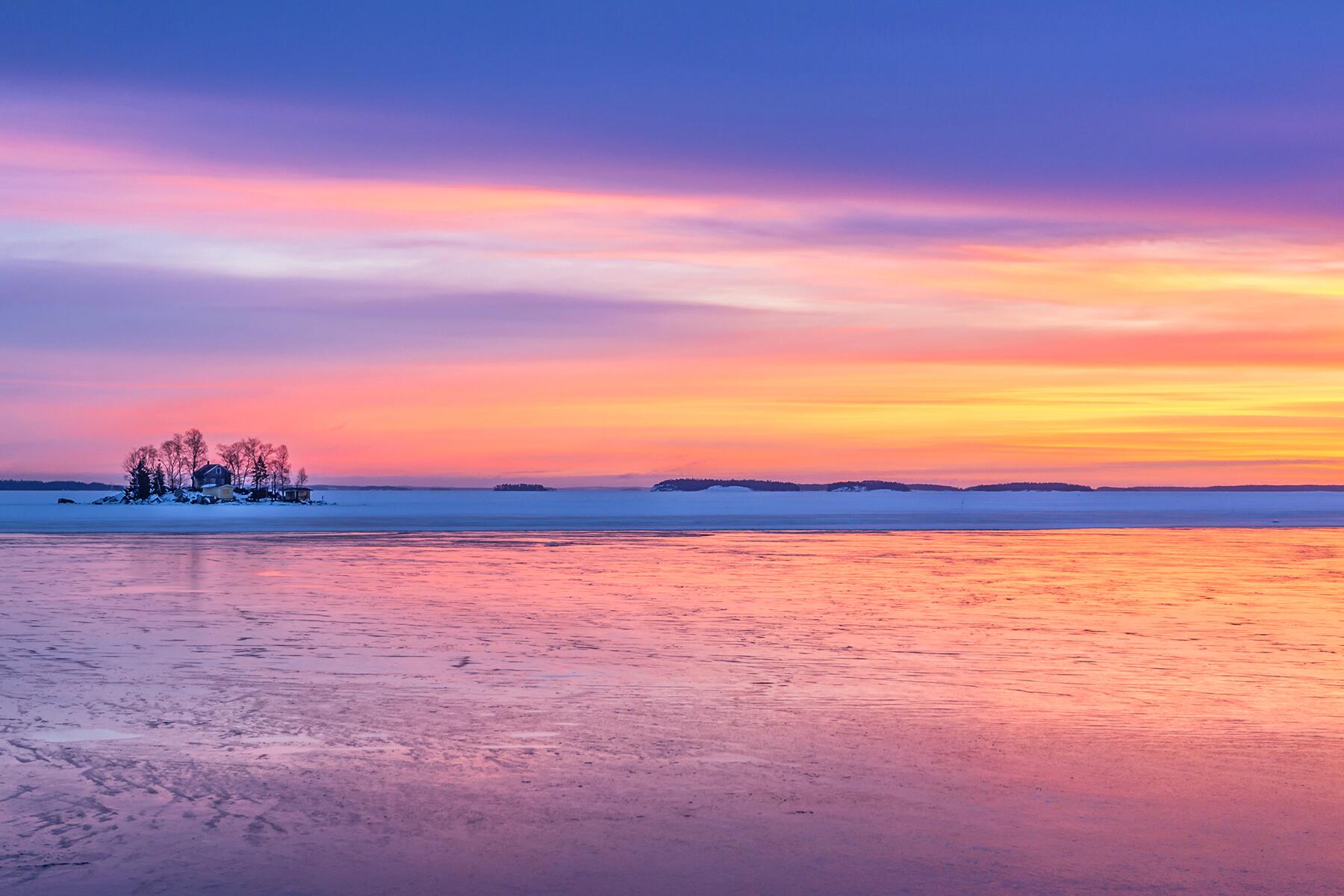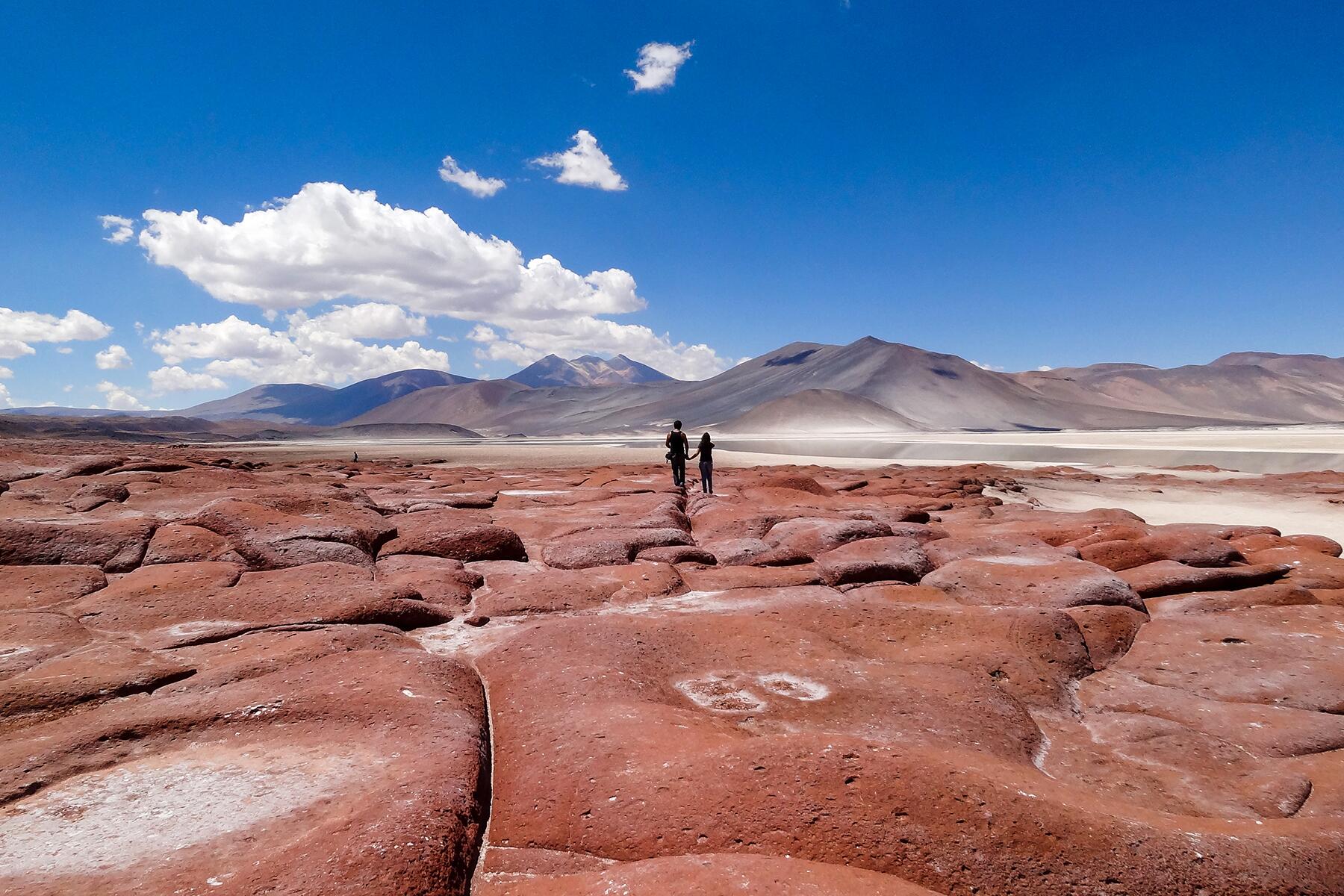The adventure paradise for thrill-seekers.
Tucked within the northern stretches of the world’s longest country—where the arid desert of Chile meets the windswept and rocky regions of Argentina and Bolivia—the Atacama Desert impresses as one of the most spectacular wildernesses on Earth. With its lunar-like landscapes encompassing a vast terrain of rust-hued mountains and golden sand dunes, the area proves to be an adventure paradise for explorers, hikers, and bikers fierce enough to brave the desert conditions. At the region’s heart is the tiny San Pedro de Atacama, a caravan town with roots extending back almost 3,000 years when it was a pit stop for Andean wool traders on their way to the Pacific Coast. This is where you’ll find the Atacama Desert’s top hotels and operators who will guide you through one of Chile’s most mesmerizing wildlands.
Top Picks for You
How do I get there?
To explore the Atacama Desert, you first need to get to Chile, set between the Andes Mountains to the east and the Pacific Ocean to the west. Your international flight will first arrive in Chile’s bustling capital, Santiago, where you can easily access a connecting flight to the Calama Airport. On arrival at the airport, there will be many transfer options to access San Pedro de Atacama, the epicenter of the region’s tourism, which is around an hour from the airport. Most hotels offer private transport to your accommodations, and there are also a host of bus companies with routes to and from Calama Airport, from Frontera del Norte to Atacama 2000.
What's the landscape like?
Welcome to Mars! But really, the Atacama Desert is the closest many of us will come to experiencing life on the red planet, as this arid, colorful desert is seemingly endless and covers a 600-mile-long region in the driest non-polar desert on Earth. During a visit, you’ll quickly realize the region is full of surprises, from canyons with lunar-like red and white sedimentary rock walls to bright pink flamingos dotting lagoons within the vast Salar de Atacama, the third-largest salt flat on the planet.
Recommended Fodor’s Video
What's the climate like?
Known for harboring some of the world’s clearest skies, the Atacama Desert is a landscape of extremes. Like a true desert climate, the region’s salt lakes, sand dunes, volcanoes, and lava fields become brutally hot by day and drop to freezing temperatures by night. It’s best to prepare for a range of conditions.
Will I get altitude sickness?
San Pedro de Atacama sits at 8,000 feet above sea level—an altitude over the threshold for conditions that generally garner altitude sickness. Prepare for mild symptoms like dizziness, headaches, and shortness of breath while walking and hiking, symptoms that can ease with medication and the use of regional medicinal teas like rica rica. Your symptoms will also decrease the longer you’re in the area.
How long does it take to visit?
Plan to stay no less than three days, the minimum amount of time to properly acclimatize to the altitude. Once you’ve built up a tolerance to the conditions, you can pursue more strenuous adventures in even higher altitudes like a trek to the turquoise pool at the top of Volcan Licancábur, one of the most iconic volcanos in the area.
Do I need to be physically fit to visit?
The Atacama Desert is an outdoor enthusiast’s playground. To experience the area to the fullest, a minimal level of physical fitness is recommended, especially due to the high-altitude conditions—you’re likely to become winded even if you’re only walking. Most hotels and tour operators offer customizable excursions—many range from half-day adventures lasting from two to five hours to full-day excursions averaging around 10 hours—that can be geared to your level of fitness, from trekking up volcanoes to slow jaunts through the basin of the salt flats.
What should I pack?
Because the Atacama Desert’s temperatures fluctuate drastically from day to night, it’s best to pack a range of gear. For day trips, bring light summer clothes like breathable shirts and shorts—and don’t skimp on the sunscreen, as the UV rays in this area of the world are stronger than usual. For early-morning excursions or sunset hikes, be sure to bring layers to pair over your summer clothes— down jackets work well over fleece sweaters and long hiking pants and will keep you warm once the sun’s absence brings about brisk temperatures.
What adventure activities can I do?
Whether you love to mountain bike through canyons, hike demanding trails, or shuffle through scree in hidden gorges, there’s no shortage of adventures to be had in the Atacama Desert. During your outdoor pursuits, be prepared to get a little dirty—especially if you plan to see the area’s most thrilling under-the-radar sites. Though adventure is certainly the main draw of the Atacama Desert, leisure travelers will find plenty of interesting outings, too, from relaxing bike rides to downtown San Pedro and horseback rides through sand dunes at sunset to exploring tiny towns with illuminating archaeological sites. Don’t miss the nighttime astronomic tours, where you can learn more about local legends of the stars.
What's the deal with the Moon Valley?
Learn what it feels like to walk on the moon during a visit to the Atacama Desert’s own Valle de la Luna, or Moon Valley, located in the heart of the Cordillera de la Sal range around 6 miles from downtown San Pedro. This colorful landscape is in the Sierra Obate depression and was formed thanks to the tectonic pressure of the mountainous region. Declared a natural sanctuary in 1982, most visitors to the Moon Valley arrive at dusk or dawn to catch one of the area’s transcendental sunrises and sunsets, when the valley transforms into an explosion of colors painting the horizon with shades of amber and gold.
Does NASA really do experiments here?
Yes, the rumors are true—NASA really does experiments in the Atacama Desert, as the landscape harbors the closest conditions to Mars that we have on Earth. The absence of most life –plants, animals, and even water—make the area one of the most inhospitable regions on the planet, prompting NASA and the European Space Agency to test their Martian rovers here to see how the vehicles would function in untamed, windswept, and barren conditions.
Will I see crowds?
It depends. Popular sites like the Moon Valley are often teeming with crowds, especially during sunrise and sunset. But most places you go won’t be packed; plus, there’s always a way around crowds. Even within the Atacama Desert’s most popular sites, there are secret spots like the little-known Cañón de Kari near the Moon Valley, a less-trodden path weaving through a canyon named for the green color of its copper ore.
Can I go with kids?
Yes. Kids and families will love taking part in guided walks and adventures throughout the region. From learning how the area’s red rock walls formed to hearing local legends of the stars, kids will enjoy exploring the region on foot, as myriad flat paths are available. Many tour operators and hotels offer van transportation to each activity, which includes stopping at secure viewing points for kids to admire the landscape. Also, consider taking bikes to check out not-to-miss spots in the town of San Pedro like the church.
Will I see any wildlife?
In regions of the Atacama Desert situated 13,000 feet above sea level, precipitation levels are higher, which creates plentiful green terrain rife with wetlands and meadows. As such, most of the wildlife in the region are concentrated in these areas with the most popular being the El Tatio geysers. Here, amidst the largest geothermal field in the southern hemisphere, you’re likely to see vicuñas, foxes, and even flamingos in and around the site’s bubbling hot springs.
Where should I stay?
Most lodges are in downtown San Pedro and include a range of high-to-low options. At the luxurious Awasi Atacama, 12 suites built from adobe, stone, and wood mirror the town’s original settlements and frame a central pool and dining area, while nearby Explora Atacama occupies a 42-acre plot of land inclusive of horse stables, a pool and Jacuzzi, and even a traditional adobe farmhouse for convivial barbecues. If you’re visiting the area for extra space and ethereal spa treatments, stay outside of downtown San Pedro at Alto Atacama, a property set beneath a mesmerizing red rock face and host to Puri Spa, where you can find a Turkish bath and indoor-outdoor hot tubs.
Do I need a guide?
Intrepid travelers can rent a car and explore on their own, though purchasing maps and gaining thorough intel is advised, as most areas are desolate and are without any cell service. Most lodges offer half- and full-day tours in the room rate. At Awasi Atacama, each room comes with a private guide to explore where you want while going at your own pace. Explora Atacama offers mostly adventure excursions in groups, while Alto Atacama offers group tours by van.
How much does it cost?
Most sites in the Atacama Desert are free to visit aside from the area’s most popular attraction like the Moon Valley, which costs international visitors 1,500 Chilean Pesos to enter. Because most hotels offer their own adventure activities, the cost of each outing is almost always bundled within your rate—so odds are you will not have to pay out of pocket to enter any sites. Prices vary for luxury accommodations and economic options like hostels. Regardless style of lodging you choose, it’s best to book months in advance to secure a spot.
When is the best time to go?
The high season for Atacama runs from November through February when the area is pleasantly warm by day and brisk by night. But with the good weather comes more crowds. If your priority is to visit without crowds, shoulder season is also nice—it takes place during North America’s spring and autumn and prices for hotel nights tend to drop drastically.
Do you have any photo tips?
With its intense, sunny climate, it takes a few tools to properly photograph the Atacama Desert. It’s vital to load your photography kit with a lens hood to create shade for your images and a UV filter to ensure both your photographs are optimal quality and your gear is protected from the sandy terrain that could potentially scratch your lens. If you want even more functionality, add a neutral-density filter to your kit to avoid any unwanted landscape shots with sun flares. But as a best practice, try to shoot the region’s most beautiful sites either at sunrise or sunset, as the soft light will make your images vibrant and prevent them from appearing flat or overexposed.




